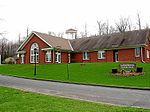Litchfield–South Roads Historic District
Colonial architecture in the United StatesFederal architecture in ConnecticutGreek Revival architecture in ConnecticutHarwinton, ConnecticutHistoric districts on the National Register of Historic Places in Connecticut ... and 3 more
NRHP infobox with nocatNational Register of Historic Places in Litchfield County, ConnecticutUse mdy dates from August 2023

The Litchfield–South Roads Historic District encompasses part of the traditional town center of Harwinton, Connecticut. Settled in the second quarter of the 18th century, and centered at the junction of Connecticut Route 4 with North and South Roads, the town center includes a variety of mainly 19th century residential architecture, several churches, and municipal buildings. It was listed on the National Register of Historic Places in 1996.
Excerpt from the Wikipedia article Litchfield–South Roads Historic District (License: CC BY-SA 3.0, Authors, Images).Litchfield–South Roads Historic District
Litchfield Road,
Geographical coordinates (GPS) Address Nearby Places Show on map
Geographical coordinates (GPS)
| Latitude | Longitude |
|---|---|
| N 41.770833333333 ° | E -73.060555555556 ° |
Address
Litchfield Road 10
06791
Connecticut, United States
Open on Google Maps








